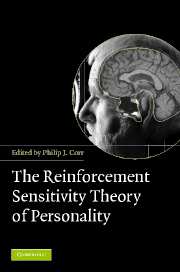Book contents
- Frontmatter
- Contents
- List of abbreviations
- List of figures
- List of tables
- List of contributors
- Preface
- 1 Reinforcement Sensitivity Theory (RST): introduction
- 2 The neuropsychology of fear and anxiety: a foundation for Reinforcement Sensitivity Theory
- 3 Animal cognition and human personality
- 4 The behavioural activation system: challenges and opportunities
- 5 Reinforcement Sensitivity Theory and personality
- 6 Reinforcement sensitivity scales
- 7 Performance and conditioning studies
- 8 Psychophysiological studies
- 9 Reinforcement Sensitivity Theory and mood induction studies
- 10 Neuro-imaging and genetics
- 11 Reinforcement Sensitivity Theory and psychosomatic medicine
- 12 RST and clinical disorders: anxiety and depression
- 13 RST and psychopathy: associations between psychopathy and the behavioral activation and inhibition systems
- 14 Behavioural activation and inhibition in social adjustment
- 15 Reinforcement sensitivity in the workplace: BIS/BAS in business
- 16 Formal and computational models of Reinforcement Sensitivity Theory
- 17 Reinforcement Sensitivity Theory: a critique from cognitive science
- 18 The contribution of Reinforcement Sensitivity Theory to personality theory
- General Index
- Index of Names
- References
2 - The neuropsychology of fear and anxiety: a foundation for Reinforcement Sensitivity Theory
Published online by Cambridge University Press: 31 January 2011
- Frontmatter
- Contents
- List of abbreviations
- List of figures
- List of tables
- List of contributors
- Preface
- 1 Reinforcement Sensitivity Theory (RST): introduction
- 2 The neuropsychology of fear and anxiety: a foundation for Reinforcement Sensitivity Theory
- 3 Animal cognition and human personality
- 4 The behavioural activation system: challenges and opportunities
- 5 Reinforcement Sensitivity Theory and personality
- 6 Reinforcement sensitivity scales
- 7 Performance and conditioning studies
- 8 Psychophysiological studies
- 9 Reinforcement Sensitivity Theory and mood induction studies
- 10 Neuro-imaging and genetics
- 11 Reinforcement Sensitivity Theory and psychosomatic medicine
- 12 RST and clinical disorders: anxiety and depression
- 13 RST and psychopathy: associations between psychopathy and the behavioral activation and inhibition systems
- 14 Behavioural activation and inhibition in social adjustment
- 15 Reinforcement sensitivity in the workplace: BIS/BAS in business
- 16 Formal and computational models of Reinforcement Sensitivity Theory
- 17 Reinforcement Sensitivity Theory: a critique from cognitive science
- 18 The contribution of Reinforcement Sensitivity Theory to personality theory
- General Index
- Index of Names
- References
Summary
Personality factors, as normally studied, are sources of variation that are stable over time and that derive from underlying properties of an individual more than current changes in their environment. They account for behavioural differences between individuals presented with identical environments that show consistent patterns within that individual across time. As such, an ultimate goal of personality research must be to identify the relatively static biological variables that determine the superficial factor structure evident in behaviour and other measures. This is not to deny the importance of the environment in controlling personality. But, to produce consistent long-term effects, environmental influences must be mediated by, and instantiated in, biological systems. Biology can also be viewed as more fundamental in that environmental events (such as an impact to the front of the head) have permanent effects on personality not in relation to the external parameters of the event (such as the force of impact) but rather in relation to the precise extent of change the event induces in the brain.
Those interested in individual variation in the tendency to neurotic disorders have been particularly inclined to theorize in terms of either the real or the conceptual nervous system. Pavlov saw variation in the response of his dogs to both traumatic and everyday events as arising from the ‘Strength of the Nervous System’ – a purely theoretical construct, albeit with a consistent behavioural structure (Gray 1964, 1967).
- Type
- Chapter
- Information
- The Reinforcement Sensitivity Theory of Personality , pp. 44 - 94Publisher: Cambridge University PressPrint publication year: 2008
References
- 55
- Cited by



